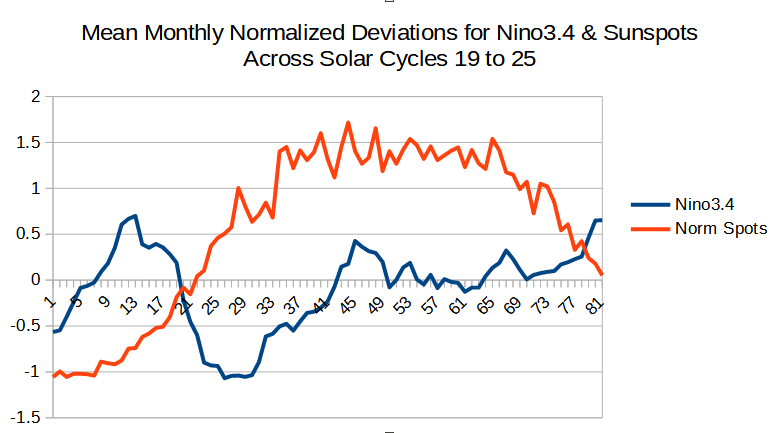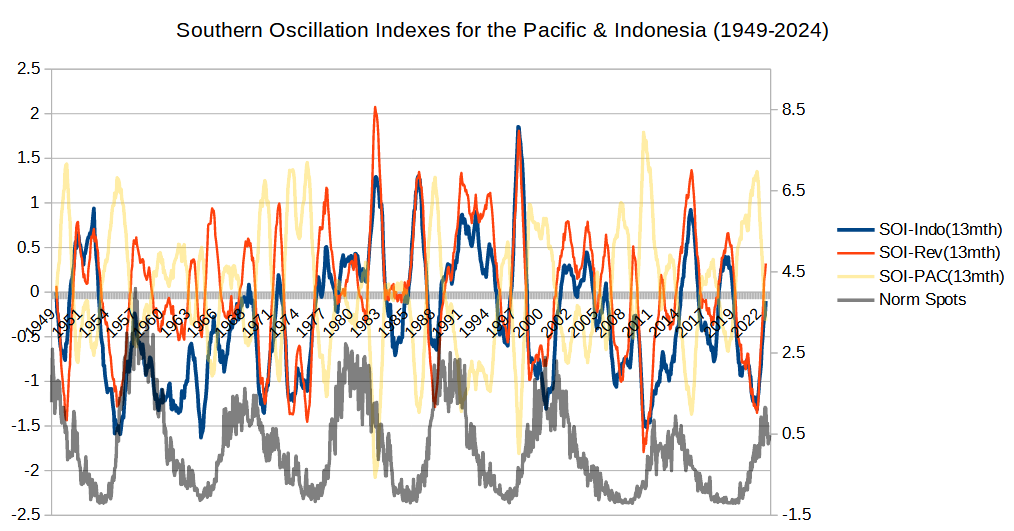|
|
Post by missouriboy on Jan 26, 2024 22:46:04 GMT
 If you compare the range of ENSO forecasts to the historical solar-cycle-specific ENSO tracks in the chart below, you will note that the mid-range forecasts look closest to the ENSO 3.4 track of Solar Cycle 20, which started its deep La Nina plunge at about week 53, and reached a depth of -1.5 about 2 years later. Not since SC19 has a large El Nino occurred in this part of the solar progression.  International Research Institute for Climate and Society. Betcha they are well up the DEI ladder.  |
|
|
|
Post by ratty on Jan 26, 2024 23:07:25 GMT
|
|
|
|
Post by missouriboy on Jan 26, 2024 23:21:55 GMT
Thanks.  It's fixed. |
|
|
|
Post by duwayne on Jan 27, 2024 19:17:02 GMT
 If you compare the range of ENSO forecasts to the historical solar-cycle-specific ENSO tracks in the chart below, you will note that the mid-range forecasts look closest to the ENSO 3.4 track of Solar Cycle 20, which started its deep La Nina plunge at about week 53, and reached a depth of -1.5 about 2 years later. Not since SC19 has a large El Nino occurred in this part of the solar progression.  International Research Institute for Climate and Society. Betcha they are well up the DEI ladder.  Missouri, if you plot the average of all the cycles posted above do you get a line that shows some effect from the Solar activity? Is the line lower at the beginning and the end of the cycle with a peak in the middle, for example? |
|
|
|
Post by ratty on Jan 27, 2024 23:59:41 GMT
[ Snip ] Missouri, if you plot the average of all the cycles posted above do you get a line that shows some effect from the Solar activity? Is the line lower at the beginning and the end of the cycle with a peak in the middle, for example? He will want another pay rise.  |
|
|
|
Post by missouriboy on Jan 28, 2024 0:07:02 GMT
Normalized sunspot and Nino3.4 deviations averaged across seven solar cycles. Medium to large El Ninos "generally" occur in the first 21 months of the the "official" start date. Two cycles (SC19 & SC25) had either NO El Nino (SC19) or a very small El Nino (SC25). Seventy years apart. I have suggested that the warm water that initiates these early events may come from the Indian Ocean during negative IOD events. La Ninas follow in the next 21 months, rising by an average temp. of 1.5C. This second phase seems to have the same general slope as the averaged normal sunspot deviations. Intense solar inputs? This slope levels off from the 5th year.  |
|
|
|
Post by missouriboy on Feb 1, 2024 23:48:25 GMT
University Alabama Huntsville (UAH) Atmospheric Temperature Anomalies
Lower stratosphere temperature anomalies were higher during SC21 and 22. They occur with volcanic activity (St. Helens & Pinatubo) and on the run-up slope of solar cycles ... specifically SC25. Need a tropospheric water vapor data series. Current El Nino started just before Hunga Tonga but stratospheric temp anomalies declined as tropospheric temp anomalies increased.
 |
|
|
|
Post by missouriboy on Feb 10, 2024 22:57:41 GMT
I found a separate monthly Southern Oscillation Index dataset for Indonesia from 1949 to Current constructed from different base stations than our long-running Pacific SOI. Largely similar time series, with a large, distinct difference for Indonesia surrounding Solar Cycle 19. Many other indicators go whacko around SC19 ... which is six cycles (~70 years) removed from SC25 ... which may also be going whacko. Solar Cycle 13, which we are comparing to SC25, is also six cycles removed from SC19. Probably nothing right?  |
|
|
|
Post by ratty on Feb 11, 2024 5:27:27 GMT
I found a separate monthly Southern Oscillation Index dataset for Indonesia from 1949 to Current constructed from different base stations than our long-running Pacific SOI. Largely similar time series, with a large, distinct difference for Indonesia surrounding Solar Cycle 19. Many other indicators go whacko around SC19 ... which is six cycles (~70 years) removed from SC25 ... which may also be going whacko. Solar Cycle 13, which we are comparing to SC25, is also six cycles removed from SC19. Probably nothing right?  Definitely something and, speaking of going whacko .... Latest BoM SOI Values |
|
douglavers
Level 3 Rank
  
Posts: 194
Member is Online
|
Post by douglavers on Feb 11, 2024 10:34:21 GMT
SOI suddenly really negative.
Belated swing into El Nino?
|
|
|
|
Post by nonentropic on Feb 11, 2024 14:24:39 GMT
I would say that the settled associations are not running to form.
If you ask me from the SOI there never was a convincing "super" El Nino and now that it has been predicted to go neutral/ La Nina it starts to look "super"
I'm thinking volcanic eruption and Stratospheric water in play and we have no plays to follow.
Skiing in Canada and US is just good enough but many resorts struggling.
|
|
|
|
Post by Sigurdur on Feb 11, 2024 15:24:09 GMT
Remember the SOI is tied to strength of Walker circulation.
|
|
|
|
Post by missouriboy on Feb 16, 2024 22:31:53 GMT
|
|
|
|
Post by missouriboy on Feb 17, 2024 1:58:24 GMT
In preparation for a La Nina tornado season? |
|
|
|
Post by Sigurdur on Feb 17, 2024 3:28:08 GMT
In preparation for a La Nina tornado season? Yep. Get ready for the barrage. Incoming!! |
|